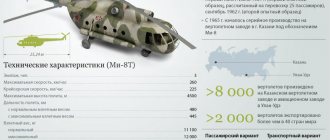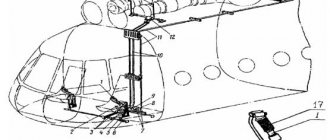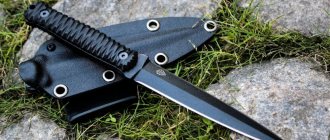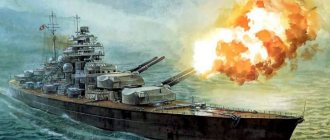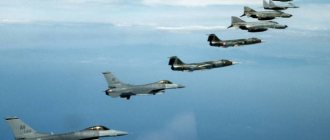Photo: Evgeny Baranov
On October 28, Russia celebrates Army Aviation Day. The main means of this type of troops are helicopters for various purposes, including combat helicopters, or, as they are also called, attack helicopters. Mi-28 helicopters have been in service with the Russian Ministry of Defense since 2013. In 1982, the combat Mi-28 took off for the first time, and 14 years later the modified Mi-28N “Night Hunter” was developed. The helicopter continues to be improved, and the Mi-28N is being replaced by the Mi-28NM, updated taking into account the combat experience in Syria. For its high flight characteristics and reliability, the new helicopter received the respectful nickname “Nikolai Mikhailovich” from the pilots.
Enhanced armor protection, increased combat survivability, a modern high-precision weapon system and other advantages of the new “Night Hunter” are in our material.
Our answer to Apache
The concept of supporting ground forces from the air with heavily armed “flying tanks”—combat helicopters—appeared in the late 1950s. The Mi-24 Crocodile, designed by the brilliant designer Mikhail Mil, took off in 1969 and became the first specialized combat helicopter in the USSR and the second in the world.
Its successor, the Mi-28, was created as a result of competition between the Mil Design Bureau and the Kamov Design Bureau for the right to create a new attack helicopter capable of resisting the American Apache attack helicopter and replacing the outdated Mi-24. For a long time, the Mi-28 and the Kamov Ka-50 were tested on approximately equal terms, but in the end the military gave preference to the Mil “air tank”. In 1982, the Mi-28 took off for the first time.
First flight of the Mi-28, November 10, 1982
The tasks of the new aircraft were to support ground forces and landing forces, destroy manpower, ground armored vehicles and low-speed air targets. During the tests, the helicopter performed excellently and confirmed the flight and technical characteristics specified in the Ministry of Defense assignment.
14 years later, a modified Mi-28N was developed, which was the first of the “twenty-eighths” to go into production. This model was created by the Milevians specifically for army aviation at a time when helicopters were massively transferred from the Air Force to the ground forces. The new vehicle had to retain all the qualities of the Mi-28 and, in addition, meet the specifics of the ground forces: work not only during the day, but also at night, as well as in any weather, have a high level of autonomy and be quite simple to operate and repair.
Mi-28N. Photo: Evgeny Volkov / wikimedia.org
To implement the night combat mode, the emphasis was placed on deep integration of all on-board equipment. Improved avionics made it possible to effectively use the power of the helicopter at night, for which the Mi-28N received the name “Night Hunter”.
The Mi-28N is capable of such “aircraft” aerobatics as “barrel”, “slide”, “dead loop”, and it can also do a specific “tail funnel”, fly backwards and sideways. These are the machines that the Russian aerobatic team “Berkuts” uses in their performances. The high maneuverability of the Mi-28N, together with a permissible normal load factor of 2.5 units, allows the use of aerial pirouettes not only to decorate aviation holidays, but also as real combat maneuvers on which the survival of a combat vehicle depends.
"Nikolai Mikhailovich" goes hunting
Mi-28NM (night modernized) is the latest modification of the Night Hunter, the development of which began in 2009. It takes into account all the comments that the Mi-28N received during state tests. Another task of modernization was the replacement of foreign components with domestic ones. Military pilots are very happy with the new helicopter, which has already received from them the respectful nickname “Nikolai Mikhailovich” for its qualities.
The developers have done a lot to make it more convenient for the crew of the Night Hunter to work, especially in the dark. Information about the operation of systems and the progress of the flight has become more extensive and visual. The helicopter has a new sighting and search system.
Mi-28NM
The armored cabin protects the crew from armor-piercing bullets and shells of up to 20 mm caliber. A full-fledged vehicle control system has been created in the navigator's cabin, so that even in the event of a direct hit in the pilot's cabin, the navigator will be able to continue the flight. A similar scheme has already been implemented in the combat training version of the Mi-28UB. According to test pilots, the Mi-28NM cabin in size and sound insulation began to resemble the cabin of a passenger aircraft.
The key innovation of the Mi-28NM was the engine. Serial Mi-28s were equipped with TV3-117 power plants, the main production of which remained in Ukraine. As part of import substitution, ODK-Klimov developed the VK-2500 engine, assembled entirely from Russian components. Its latest modification is VK-2500P and is installed on the Mi-28NM.
The new engine differs from the basic one in an upgraded automatic control system of the FADEC type and fire protection, which ensure flight safety, simplify maintenance and improve the technical characteristics of the power plant as a whole. The engine power has increased significantly, and the service life before the first major overhaul has increased from 2000 to 3000 hours/cycles. In addition, the new engine makes it possible to use the Night Hunter in a wide temperature range.
The Mi-28NM uses the design of its predecessor, and the most noticeable external difference is the N025 above-the-hub radar. This ball, located above the main rotor of the helicopter, helps the crew find targets even out of sight. Previously, such equipment was installed only on export models. The main rotor blades are made of composite materials, which makes it possible to complete the flight even if the propeller is hit by 20-30 mm caliber shells.
The “air tank” concept implies the possibility of using a wide range of weapons on a helicopter. As before, the Mi-28NM arsenal includes various types of guided and unguided missiles. Also in 2022, representatives of Mil Design Bureau said that the new helicopter will receive the country’s first multifunctional air-to-air/air-to-surface helicopter missile with a homing head. The missile has an increased range, which allows the crew to destroy targets without entering the danger zone.
Photo: Russian Helicopters
For its own protection, the “Night Super Hunter” is equipped with a laser suppression station developed by the KRET holding. Her job is to create phantom targets for enemy missiles aimed at the helicopter using a laser. The new car also has a very promising function for interacting with drones. At the same time, there are several operating scenarios - when the drone performs target designation functions for the Mi-28NM or when it is controlled by the navigator directly from the helicopter.
The Mi-28NM, like previous models, is produced by the Rostov-based Russian Helicopters holding company. Sergei Shoigu spoke about combat testing of a prototype of the new “Night Hunter” in 2022. According to the Minister of Defense, the Mi-28NM took part in combat operations in Syria, that is, the vehicle was successfully tested in hot climates and desert conditions. In the same year, the Ministry of Defense entered into a contract with the Russian Helicopters holding company for the supply of 98 Mi-28NM helicopters until the end of 2027. The “Night Super Hunter” continues to undergo tests, at the same time mass production was launched in September of this year, and very soon the Mi-28NM will join the army aviation.
The Mi-28NM helicopter is not a gift!
I thought that I wouldn’t have to return to the topic of the Mi-28, but after V.V.’s order. Putin about arming our Army with Mi-28NM helicopters, laudatory odes rained down on him from the liberal media: pilots, rejoice! Everything follows the laws of the market: “the worse the product, the more beautiful the packaging”!
"Night Super Hunter" successfully tested in Syria
“The best attack helicopters in the world! From Mi-24 to Apache and KA-52”, where “MAIN ARGUMENTS testify in favor of the new modernized helicopter MI-28 NM “Night Hunter”;
“Mi” is in place: the newest attack helicopter will soon enter the army
Formally, the new aircraft is considered a modernization of the Mi-28N. But the developers made so many changes that they got a completely new “Night Super Hunter”, superior to the previous one in all respects. So, this model has more powerful engines and control system. In addition, the helicopter ensures crew safety at a very high level, which simply has no analogues in the world. The cabin and vital components are covered with armor that can withstand hits from large-caliber bullets. The MANPADS fire warning system can detect a fired missile, analyze its trajectory and give recommendations to the pilot: to avoid or shoot heat traps. And the laser suppression station is used to divert guided missiles.
Thanks to the shock absorption system in the chassis and pilot seats, the crew can remain unharmed even if the vehicle falls from several tens of meters. And at high altitude in an emergency - leave the cockpit and land with a parachute. For this purpose there is a system for shooting side doors.”
“But the developers have made so many changes”?
But the TV presenter of “Zvezda” in a report on the occasion of the serial release of the Mi-28NM said that the engine power is limited to 2200 hp, which means that the Mi-28NM inherited the same from the “killer” Mi-28N (according to V. Bondarev) unreliable gearboxes. And the engine is the same: VK-2500.
There really are CHANGES in equipment!
Now it has become modern and very expensive, so expensive that at first M.O. refused to buy it and only by the strong-willed decision of the President was it adopted for service.
But this expensive equipment is worthless if the design of the helicopter itself is not improved! Let us remember that in Syria there were two hard landings of Mi-28N and one Mi-24P helicopters, in which 4 highly qualified pilots were killed, and when a helicopter falls without external influence on it, its armor is “like a dog’s fifth leg”!
An Mi-35 helicopter was also shot down by a missile that exploded near the tail rotor - the crew died, because when the tail rotor fails, the helicopter becomes uncontrollable in the fall and no expensive on-board equipment can help it.
The classic design has one more very weak point - the tail boom!
When flying at low altitudes (the main flights in Syria), the helicopter becomes a good target for small arms. For example, when shooting from a machine gun at the enemy. beam - control of the tail rotor is interrupted, and the beam itself, with minor damage, can even break off, because in flight the thrust is cold. the screw creates large: a) BREAKING moment; b) Torsional moment and + c) Fracture moment due to its own weight and the weight of the dryer. screw!
Hence the natural question: what was the point in spending financially on expensive equipment for the Mi-28NM helicopter, if the classical scheme itself excludes the necessary protection due to the impossibility of protecting the chemicals. beams even from small arms bullets, not counting the hv itself. screw? Okay, when there was no replacement for these helicopters, but today there are excellent coaxial helicopters,
which, when the tail unit is destroyed, do not fall like a stone, but continue to fly at speeds of up to 200k/h. and confidently land at the base airfield. Moreover, in an emergency situation, unlike the Mi-28NM, it is not the side doors that are shot off, but the rotor blades, after which the seats with the pilots eject upward.
Another “ARGUMENT” about the security of the Mi-28NM:
“Thanks to the shock absorption system in the chassis and pilot seats, the crew can remain unharmed even if the car falls from several tens of meters. And at high altitude in an emergency - leave the cockpit and land with a parachute. For this there is a system for shooting SIDE DOORS.”
How the depreciation of the landing gear saves the crew can be clearly seen in the photo when the newest Mi-28UB crashed in Korenovsk before the New Year.
Now imagine a falling helicopter, which also rotates around a vertical axis, while the pilots shoot off the side doors and leave the cockpit: on top is a rotating main rotor D = 17.3 m, and at the back is the tail rotor!!!
It seems that combat helicopter pilots did something very wrong before the Supreme Commander-in-Chief and punished them: Mi-28NM?
Are there many Ka-52 helicopters in the Army and how many Apaches do the Americans have?
“... The US Army has approximately 810 units of this helicopter.”
Ka-52 Alligator
“The helicopter was put into service in 2011, at the moment there are about 72 helicopters in the Russian Armed Forces.
Not much!!! In essence, the Government pretends that it is equipping our Army with the best helicopters in the world, but in fact it is a fraud and pilots are forced to fly backward Mi-24 ... Mi-28, of which there are “a dime a dozen” in the Army:
“To date, about a hundred Ka-52 units and more than a hundred Mi-28 Night Hunter helicopters have been delivered to the troops.
The largest helicopters remaining in service are the Mi-24 (620 units) and Mi-8 (570 units). These are reliable, but old Soviet machines, which can be used for some time after minimal modernization" (Russian Air Forces 2022: history and composition 04/30/2019 (militaryarms.ru).
Here is the modernization: “General Director of the Russian Helicopters holding company Andrei Boginsky said that Russia has modernized the Mi-24 attack helicopter. According to him, now its service life has been increased to 45 years, while previously it was 30 years” (gazeta.ru 07/02/2019).
Moreover, there was an attempt to completely stop the production of the outstanding Ka-52 helicopters in favor of the Mi-28NM, and only rallies of the workers of the plant producing the Ka-52 forced the Putin-Medvedev government to stop laying off these workers with a promise to continue the production of Alligators.
Coaxial helicopters are not only more reliable and safer than the classic design, but they also have a number of other very important advantages over classic ones, as pilots who have flown on both types have told us.
“Helicopter for Marines” (Aviation and Time, No. 5 2012, S. Drozdov, A. Bondarev)
On the Ka-29, “takeoffs and landings with a tailwind of up to 20 m/s are also possible (previously - no more than 10 m/s). They were also extended to Ka-27 helicopters. Some representatives of the military leadership began to propose adopting the Ka-29 (combat helicopter) into service with the Army Aviation as a transitional type to the Ka-50. But still, the coaxial propeller greatly confused most generals, and ultimately the Ka-29 did not make it to Afghanistan.
The Caucasian winter added its share of dangers, especially when piloting at extremely low altitudes. Frequent fogs covered the passes, and then we had to fly through gorges. Under these conditions, the scheme with coaxial propellers showed its high efficiency, which was noted by the group commander after the first flight: “You should only fly in the mountains with such helicopters.” Indeed, the absence of a tail rotor significantly FACILITATES PILOTING during dangerous gusts of side wind, which in cramped mountain conditions posed a particular threat.
It is interesting to compare the Ka-29 with the Mi-24 army helicopter, which is similar in purpose. As noted by the pilot of the 696th regiment O.N. Myagkov, “on the Ka-29, the visibility when entering the site, the absence of a tail rotor, and smaller dimensions were captivating. ...The ergonomics of the cockpit was better than on the Mi-24: weapons control is under the left hand next to the "step-throttle" handle, target search together with the navigator (you can show your finger), all navigation and start-stop controls are under the right hand - not you have to turn around and bend down.”
The absence of power consumption to compensate for the reactive torque of the main rotor (NV) gave the Kamov machine an obvious advantage over the Mi-24, created according to the classical single-rotor design. With close take-off masses and the same power of power plants, the “twenty-ninth” has a higher efficiency coefficient of NV, which is 0.65-0.70, and for helicopters with a tail rotor it is only 0.50-0.60. On a coaxial helicopter, all the engine power goes to rotating the rotors and creating lift, while the reactive moments of the rotors are mutually balanced. On the Mi-24, up to 12% of the power is spent on driving the tail rotor.
The Ka-29 has the ability to make a pedal (flat) turn in a wide range of flight speeds. It is capable of maintaining a constant flight altitude while rotating around a vertical axis. This is especially important for ensuring the safety of combat maneuvering at extremely low altitudes and over obstacles. Such a combat maneuver provides the Ka-29 with a significant advantage over the Mi-24 and allows it to quickly take an advantageous position to attack ground and surface targets while maintaining the high accuracy characteristics of a rigidly mounted weapon. In addition, the use of a flat turn significantly reduces the amount of closeness with the enemy when exiting the attack. The maneuverability of the Ka-29 when performing pedal turns is maintained from sea level to a static ceiling of 3700 m, while the Mi-24 with a tail rotor at its static ceiling of 2000 m is only capable of hovering without performing turns.
To perform vigorous turns at any angle in the hovering mode, the Ka-29 requires significantly less space, because it itself is small, and rotation occurs around the axis of rotation of the HB. Due to the slight distance of the pilot's seat from the HB axis, the Ka-29 pilot does not experience a feeling of discomfort even when the machine rotates at maximum angular speeds.
The very nature of the coaxial design provided the Ka-29 with a low level of vibration. This is achieved as a result of summing the vibrations of the upper and lower screws in such a way that the maxima of the vibration amplitudes of one, with some shift, coincide with the minima of the other. In addition, on a coaxial helicopter there are no low-frequency transverse vibrations that lead to vibrations of the pilot’s head, which are created by the tail rotor on the Mi-24. It is because of this that there is less error in aiming on the Ka-29. Thanks to the advantages of the coaxial design, it was possible to install and successfully use a laser rangefinder with a fixed sighting axis on the “twenty-ninth”. At the same time, the Mi-24 had to use an elevation, much less accurate method of measuring the range to the target.
In addition, due to the aerodynamic symmetry of the coaxial design, the Ka-29 does not have roll over the entire range of flight speeds, which is characteristic of the Mi-24. When performing maneuvers, during turns, the helicopter's tail rotor is subject to slipping due to the presence of unbalanced tail rotor thrust. This parasitic effect is absent on a coaxial helicopter, which also provides increased aiming accuracy on the Ka-29.
As N.G. recalls Ryzhkov, he even had a chance to “fight” against the Mi-24. “In 1987-89. At the Chauda training ground, with a test pilot from Moscow of the same level of training, we conducted an air battle with the sight fixed in the photo. I only flashed the Mi-24 in the crosshairs of the sight, but having put my car in the “flat turn-side turn-funnel with a pitch-up or dive” mode, it was not difficult for me to keep the Mi-24 in the crosshairs of the S-17 sight for up to 10 seconds laser range determination and automatic training of lead for firing from guns... The navigator could work with both ATGMs and a machine gun.”
The authors and editors express deep gratitude to the pilots of the 344th TsBPiPLSV.L for their assistance in working on the monograph. Gamelko. HE. Myagkov, pilot of the 710th OKPLVP and 555th ORVLP A.A. Sedakov and Honored Test Pilot of the USSR N.G. Ryzhkov."
Facts from the Afghan War..
“According to generally accepted data, during the Afghan war of 1979-1989. Soviet aviation lost 332 or 333 helicopters[1][2]. These figures refer to the Air Force of the 40th Army and do not include the losses of aviation of the border troops and the Central Asian Military District, as well as Soviet-made helicopters from the aviation of the ground forces of the DRA Armed Forces and other national ministries and departments (which in the foreign press are also classified as “Soviet” ").[3] If we take into account that the aviation of the border troops lost 62 helicopters [4], then the total losses of Soviet helicopters reach 400 units (Material from Wikipedia - the free encyclopedia).
“Thus, the irretrievable losses of the Mi-24 and Mi-8 in Afghanistan due to combat damage to the tail parts of the gliders amount to approximately a third of the total number of helicopter deaths. This also includes losses associated with the tail rotors hitting obstacles and their subsequent destruction during combat maneuvering near obstacles at low flight altitudes.” (Comparison of An-64 and Ka-50. OVE Magazine = RAF).
... “a third of the total number of helicopter deaths.” which out of 332 is ~110 helicopters, or half of the 222 shot down by the enemy! And each has 2-3 pilots, it turns out that the tail rotor added another half to those shot down! Unfortunately, this tragic result is inherent in the most classical scheme and this is a FACT!
It is strange and incomprehensible that there is such a striking advantage of coaxials over helicopters with hv. Supreme Commander-in-Chief V.V. does not understand the screw. Putin?
Or doesn't want to understand? Indeed, in the Far East, as Prime Minister, he personally admired the aerobatics of the Ka-50 helicopter and “This is how V. Khorev conveys the impression of the Prime Minister, who personally congratulated the pilot immediately after the helicopter landed:
Even from Vladimir Putin’s face it was clear that he appreciated our car. And he said briefly: “This technique is breathtaking!” (“Black Shark” dives into Chechnya - VladNews 1999), but after becoming President, he removes it from service in favor of the clumsy, and even unreliable Mi-28N!
And further. If in Afghanistan, instead of the Mi-24, the Ka-29 had been launched into combat work, then out of the above-mentioned 110 helicopters, the pilots would have been alive and many would have continued to fight until the end of the war!
To the longevity of the Mi-24: “Commander-in-Chief of the Soviet Air Force Pavel Kutakhov, judging that no modernization of the Mi-24 would help, initiated the creation of a new generation combat helicopter. On December 16, 1976, a closed joint resolution of the CPSU Central Committee and the USSR Council of Ministers No. 1043-361 appeared on the development of a promising combat helicopter" (Requiem for the Mi-28N: why Russian combat helicopters are falling... ru.krymr.com), which also applies to the next modernization of the Mi-28N 24: Mi-28NM.
And, by the way, the news: “MOSCOW, February 3 - RIA Novosti. The Russian Ministry of Defense expects to receive 423 modern helicopters by 2027, including 96 Mi-28NM attack helicopters, said Deputy Defense Minister Alexey Krivoruchko. Earlier, Krivoruchko reported that the military department ordered 98 Mi-28NM helicopters, two helicopters of the pilot batch have already been transferred to the Ministry of Defense. Rambler reports this.
In Russia, the “super-perfect” Mi-28NM is being supplied to replace the Mi-28N.
In the USA, “Apache” was not upgraded to “ApacheNM”, but they are preparing a high-speed coaxial S-97 Rider, which has been undergoing flight tests in the air for a long time.
Another one: transport-landing coaxial high-speed SB>1.
“The SB>1 high-speed helicopter was tested with the landing gear retracted and accelerated to 130 knots. February 4, 2020
The mass of the high-speed helicopter is 13.6 tons. It can reach speeds of up to 250 knots and carry 12 troops. The machine is built in a coaxial design with a tail pusher rotor.”
The design of both helicopters was copied from our Ka-92, work on which was frozen by philologists, sociologists, financiers and similar leaders of our Aviation!
Vitaly Belyaev, especially for Avia.pro
